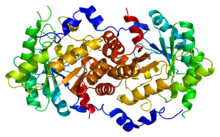5-amminolevulinato deidratasi

Questa voce sull'argomento enzimi è solo un abbozzo.
Contribuisci a migliorarla secondo le convenzioni di Wikipedia. Segui i suggerimenti del progetto di riferimento.
| 5-amminolevulinato deidratasi | |
|---|---|
 Modello tridimensionale dell'enzima | |
| Numero EC | 4.2.1.24 |
| Classe | Liasi |
| Banche dati | BRENDA, EXPASY, GTD, PDB (RCSB PDB PDBe PDBj PDBsum) |
| Fonte: IUBMB | |
| Modifica dati su Wikidata · Manuale | |
La 5-amminolevulinato deidratasi (porfobilinogeno sintasi) è un enzima citosolico che catalizza la reazione tra due molecole di acido 5-aminolevulinico per formare porfobilinogeno, il che rappresenta la seconda tappa del processo biosintetico dell'eme. È una proteina con peso di 280 KDa costituita da otto subunità, di cui quattro interagiscono con l'acido 5-aminolevulinico. L'ALA deidratasi è un enzima zinco-dipendente. È inibito da molti metalli pesanti e particolarmente dal piombo, ed infatti, in caso di avvelenamento da piombo, l'acido 5-aminolevulinico si accumula nell'organismo senza essere trasformato in porfobilinogeno proprio a causa dell'inibizione di questo enzima.
Bibliografia
- Eiberg H, Mohr J, Nielsen LS, delta-Aminolevulinatedehydrase: synteny with ABO-AK1-ORM (and assignment to chromosome 9), in Clin Genet, vol. 23, n. 2, giugno 1983, pp. 150–4, DOI:10.1111/j.1399-0004.1983.tb01864.x, PMID 6839527.
- Beaumont C, Foubert C, Grandchamp B, Weil D, Van Cong N'Guyen, Gross MS, Nordmann Y, Assignment of the human gene for delta aminolevulinate dehydrase to chromosome 9 by somatic cell hybridization and specific enzyme immunoassay, in Ann Hum Genet, vol. 48, Pt 2, agosto 1984, pp. 153–9, DOI:10.1111/j.1469-1809.1984.tb01010.x, PMID 6378062.
- Bernard A, Lauwerys R, Metal-induced alterations of delta-aminolevulinic acid dehydratase, in Ann. N. Y. Acad. Sci., vol. 514, 1988, pp. 41–7, DOI:10.1111/j.1749-6632.1987.tb48759.x, PMID 3327436.
- Jaffe EK, The porphobilinogen synthase catalyzed reaction mechanism, in Bioorg. Chem., vol. 32, n. 5, 2005, pp. 316–25, DOI:10.1016/j.bioorg.2004.05.010, PMID 15381398.
- Roels HA, Buchet JP, Lauwerys RR, Sonnet J, Comparison of in vivo effect of inorganic lead and cadmium on glutathione reductase system and delta-aminolevulinate dehydratase in human erythrocytes, in British journal of industrial medicine, vol. 32, n. 3, 1975, pp. 181–92, PMC 1008057, PMID 1156566.
- Ishida N, Fujita H, Fukuda Y, et al., Cloning and expression of the defective genes from a patient with delta-aminolevulinate dehydratase porphyria, in J. Clin. Invest., vol. 89, n. 5, 1992, pp. 1431–7, DOI:10.1172/JCI115732, PMC 443012, PMID 1569184.
- Dawson SJ, White LA, Treatment of Haemophilus aphrophilus endocarditis with ciprofloxacin, in J. Infect., vol. 24, n. 3, 1992, pp. 317–20, DOI:10.1016/S0163-4453(05)80037-4, PMID 1602151.
- Astrin KH, Kaya AH, Wetmur JG, Desnick RJ, RsaI polymorphism in the human delta-aminolevulinate dehydratase gene at 9q34, in Nucleic Acids Res., vol. 19, n. 15, 1991, p. 4307, DOI:10.1093/nar/19.15.4307-a, PMC 328595, PMID 1678509.
- Wetmur JG, Kaya AH, Plewinska M, Desnick RJ, Molecular characterization of the human delta-aminolevulinate dehydratase 2 (ALAD2) allele: implications for molecular screening of individuals for genetic susceptibility to lead poisoning, in Am. J. Hum. Genet., vol. 49, n. 4, 1991, pp. 757–63, PMC 1683158, PMID 1716854.
- Plewinska M, Thunell S, Holmberg L, et al., delta-Aminolevulinate dehydratase deficient porphyria: identification of the molecular lesions in a severely affected homozygote, in Am. J. Hum. Genet., vol. 49, n. 1, 1991, pp. 167–74, PMC 1683193, PMID 2063868.
- Potluri VR, Astrin KH, Wetmur JG, et al., Human delta-aminolevulinate dehydratase: chromosomal localization to 9q34 by in situ hybridization, in Hum. Genet., vol. 76, n. 3, 1987, pp. 236–9, DOI:10.1007/BF00283614, PMID 3036687.
- Gibbs PN, Jordan PM, Identification of lysine at the active site of human 5-aminolaevulinate dehydratase, in Biochem. J., vol. 236, n. 2, 1986, pp. 447–51, PMC 1146860, PMID 3092810.
- Wetmur JG, Bishop DF, Cantelmo C, Desnick RJ, Human delta-aminolevulinate dehydratase: nucleotide sequence of a full-length cDNA clone, in Proc. Natl. Acad. Sci. U.S.A., vol. 83, n. 20, 1986, pp. 7703–7, DOI:10.1073/pnas.83.20.7703, PMC 386789, PMID 3463993.
- Wetmur JG, Bishop DF, Ostasiewicz L, Desnick RJ, Molecular cloning of a cDNA for human delta-aminolevulinate dehydratase, in Gene, vol. 43, n. 1-2, 1986, pp. 123–30, DOI:10.1016/0378-1119(86)90015-6, PMID 3758678.
- Doss M, von Tiepermann R, Schneider J, Acute hepatic porphyria syndrome with porphobilinogen synthase defect, in Int. J. Biochem., vol. 12, n. 5-6, 1981, pp. 823–6, DOI:10.1016/0020-711X(80)90170-6, PMID 7450139.
- Kaya AH, Plewinska M, Wong DM, et al., Human delta-aminolevulinate dehydratase (ALAD) gene: structure and alternative splicing of the erythroid and housekeeping mRNAs, in Genomics, vol. 19, n. 2, 1994, pp. 242–8, DOI:10.1006/geno.1994.1054, PMID 8188255.
- Akagi R, Yasui Y, Harper P, Sassa S, A novel mutation of delta-aminolaevulinate dehydratase in a healthy child with 12% erythrocyte enzyme activity, in Br. J. Haematol., vol. 106, n. 4, 1999, pp. 931–7, DOI:10.1046/j.1365-2141.1999.01647.x, PMID 10519994.
- Akagi R, Shimizu R, Furuyama K, et al., Novel molecular defects of the delta-aminolevulinate dehydratase gene in a patient with inherited acute hepatic porphyria, in Hepatology, vol. 31, n. 3, 2000, pp. 704–8, DOI:10.1002/hep.510310321, PMID 10706561.
- Kervinen J, Jaffe EK, Stauffer F, et al., Mechanistic basis for suicide inactivation of porphobilinogen synthase by 4,7-dioxosebacic acid, an inhibitor that shows dramatic species selectivity, in Biochemistry, vol. 40, n. 28, 2001, pp. 8227–36, DOI:10.1021/bi010656k, PMID 11444968.
Voci correlate
Collegamenti esterni
- (EN) ALAD, su Enciclopedia Britannica, Encyclopædia Britannica, Inc.

 Portale Biologia
Portale Biologia Portale Chimica
Portale Chimica








